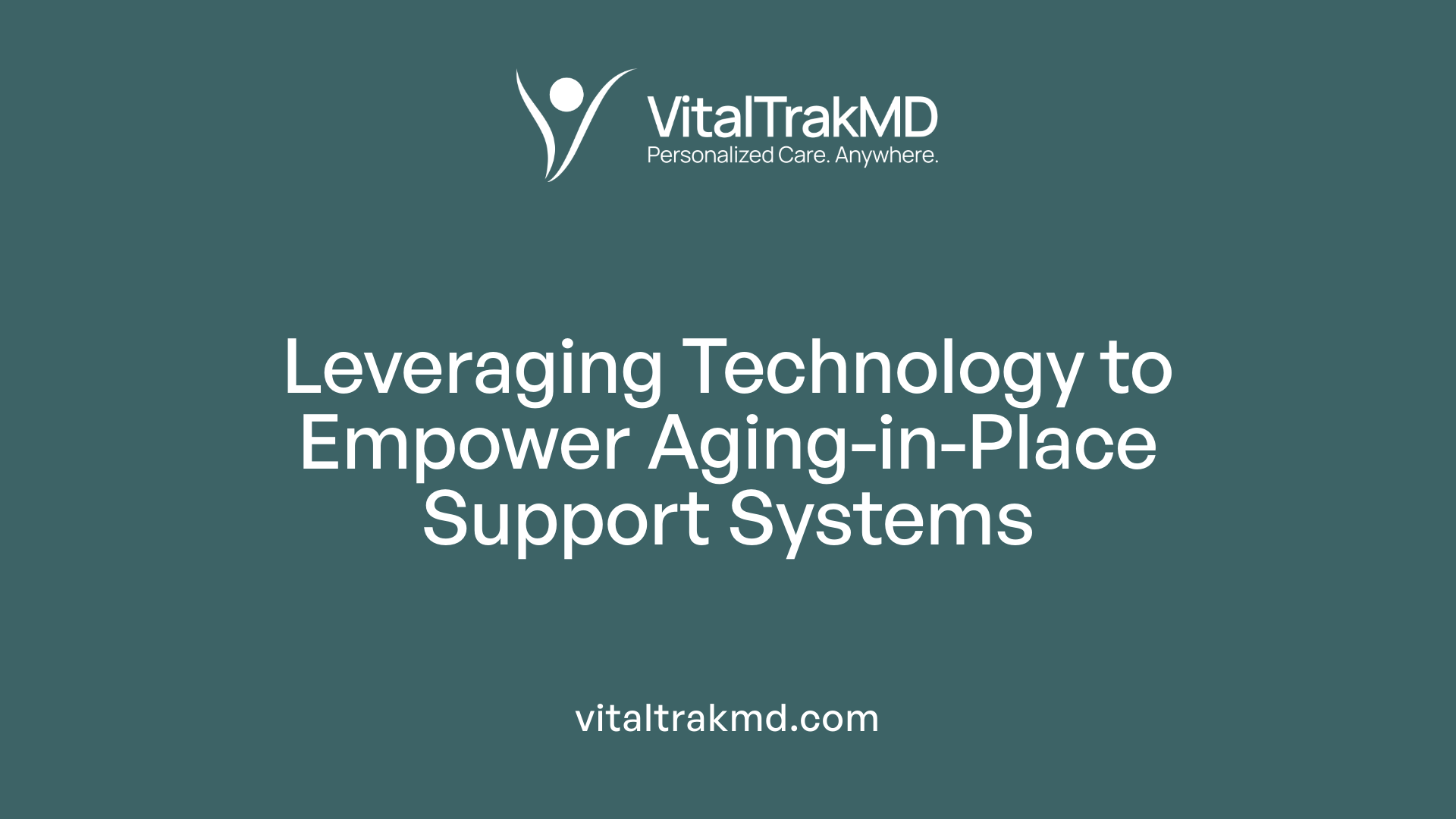The Future of Aging-in-Place Through Telehealth and Hybrid Care

Understanding the Shift Towards Telehealth and Hybrid Care Models
As the global population ages, healthcare systems are increasingly turning to innovative digital solutions to support aging-in-place. Telehealth and hybrid care models are at the forefront of this transformation, offering new pathways for seniors to maintain independence and receive high-quality care from their homes. This article explores the evolution, benefits, challenges, and future opportunities of these models in transforming elder care.
The Role of Technology in Aging-in-Place Support Systems

What role do remote monitoring, assistive devices, and digital health tools play in supporting older adults to age in place?
Remote monitoring technologies, assistive devices, and digital health tools are transforming how older adults maintain independence at home. Innovations like wearable sensors continuously track vital signs such as heart rate, blood pressure, and oxygen levels. These devices can alert healthcare providers or caregivers to early warning signs of health issues, enabling proactive interventions.
Smart home systems enhance safety and convenience by integrating sensors, cameras, and voice-activated controls. They help detect falls, monitor activity patterns, and manage household safety features, reducing risks within the living environment.
Digital health tools include telemonitoring platforms and remote communication systems that facilitate real-time interactions between older adults and healthcare professionals. This integration allows for ongoing health management, medication reminders, and quick response to emergencies.
By utilizing these technologies, older adults can effectively manage chronic conditions like heart failure, diabetes, and COPD from the comfort of their homes. They also support mental health through virtual counseling and social engagement platforms.
The collective use of remote monitoring devices, assistive technologies, and digital health tools diminishes the reliance on institutional care, lessens caregiver strain, and propels aging-in-place. Their design prioritizes ease of use and relevance for older users, promoting long-term adoption. Overall, these tools empower seniors to lead safer, healthier, and more autonomous lives within their communities.
Supporting and Expanding Aging-in-Place through Telehealth and Hybrid Care
How can telehealth and hybrid care models support aging-in-place and what is their future potential?
Telehealth and hybrid care approaches are transforming how older adults live independently at home. By providing remote access to healthcare through virtual consultations, remote patient monitoring, and assistive technologies, these models help seniors manage chronic conditions, reduce hospitalizations, and maintain their independence.
Video or phone-based consultations allow seniors to connect with healthcare providers without the need to travel, which is especially beneficial for those with mobility issues or living in rural areas. Remote health monitoring devices track vital signs such as blood pressure, heart rate, and oxygen levels, enabling earlier intervention if complications arise.
Assistive technologies like wearable sensors, smart home systems, and AI-powered companions further enhance safety and health management. For example, wearables can alert caregivers about falls or abnormal health metrics, while smart sensors can detect environmental hazards.
Effective care coordination is facilitated through integrated electronic health records and caregiver support tools, ensuring that each aspect of a senior’s health is tracked and managed seamlessly.
Despite these advancements, challenges such as technological literacy, sensory impairments, and access disparities remain. Principles focusing on person-centered, equitable, and accessible care are guiding current efforts to overcome these issues.
Looking toward the future, continuous innovations in AI, data sharing, and digital health tools promise increasingly personalized, efficient, and inclusive care models. AI algorithms can tailor health interventions based on individual data, improving outcome predictions and care plans.
Moreover, smart home devices and AI-powered virtual assistants will offer companionship and health monitoring, helping seniors feel supported and secure.
As these technologies evolve, they will expand reach into underserved communities, rural areas, and diverse populations, making aging-in-place more feasible and sustainable for a broader range of seniors. Overall, the future of telehealth and hybrid care holds great promise for promoting independence, enhancing quality of life, and building resilient, accessible healthcare systems for aging populations.
Enhancing Healthcare Delivery, Safety, and Staff Efficiency
How does telehealth and hybrid care impact healthcare delivery, patient safety, and staff efficiency for the aging population?
Telehealth and hybrid care models transform healthcare for older adults by making it more accessible and efficient. These technologies extend care beyond traditional clinics, helping seniors in rural or underserved communities receive timely medical attention without long-distance travel.
For chronic disease management, remote monitoring devices such as RPMs collect vital data like heart rate, blood pressure, and oxygen levels. Continuous tracking allows healthcare providers to detect early signs of serious complications, enabling earlier interventions and reducing hospitalizations.
Studies have shown that virtual care can cut down unnecessary emergency visits and hospital readmissions. For example, managing conditions like congestive heart failure and diabetes at home prevents disease progression and supports aging-in-place.
Staff workflows benefit from these innovations by decreasing in-person visits and freeing up clinical resources. Interdisciplinary teams can collaborate more effectively through virtual team-based care planning, enhancing coordination and reducing errors.
Virtual workflows such as tele-rounding, tele-nursing, and remote patient observation help mitigate provider burnout, especially amid staffing shortages. Technologies like teletriage and teleconsultations speed up diagnosis and treatment, which is crucial during health crises.
However, integrating telehealth successfully relies on overcoming barriers like older adults' limited tech skills, infrastructure gaps, and regulatory challenges. Facilitators include technological support, caregiver involvement, and policies that expand audio-only access to ensure equity.
In sum, telehealth and hybrid care models make healthcare delivery more comprehensive and responsive. They improve safety through continuous monitoring, reduce workload pressures on staff, and foster a patient-centered environment that promotes independent living and health equity.
Digital Health Solutions: Improving Accessibility and Quality of Life
How do digital health solutions improve accessibility, preventive care, and quality of life for older adults?
Digital health solutions have transformed how older adults access healthcare and manage their health. Remote healthcare options like telemedicine allow seniors to consult with healthcare providers without leaving home, which is especially valuable for those in rural or underserved areas. Wearable sensors and mobile apps enable continuous health monitoring, providing real-time data on vital signs such as heart rate, blood pressure, and oxygen levels.
These technologies support early detection of potential health issues, helping to prevent complications before they become severe. For instance, remote monitoring can identify early signs of cardiovascular problems, diabetes complications, or falls, prompting timely interventions.
Beyond physical health, digital tools also bolster mental health support through virtual counseling and therapy sessions, reducing social isolation and enhancing emotional well-being. They promote active engagement in daily health routines, encouraging physical activity and healthier behaviors.
Despite barriers like technological literacy and infrastructure gaps, continuous innovation aims to widen access by developing user-friendly devices and multilingual support. Overall, these solutions help older adults stay healthier longer, maintain independence, and enjoy improved quality of life.
Strategic Frameworks and Policies Supporting Telehealth Integration

What are effective strategies, policies, and frameworks for integrating telehealth into aging care?
Integrating telehealth into care for older adults involves multiple strategic and policy-driven efforts. One essential component is developing user-friendly technologies that cater to the needs of seniors, including simple interfaces and multilingual support. Complementing this technological focus are digital literacy programs aimed at empowering older adults and their caregivers to comfortably navigate telehealth tools.
Supportive policies are vital for establishing a robust telehealth infrastructure. These include adopting interoperability standards that ensure seamless data exchange across different health systems and devices. Additionally, safeguarding data security and privacy is paramount, fostering trust among users and compliance with regulations.
Promoting health equity is central to these strategies. Frameworks such as the Expanded Partnership for Innovation in Health Systems (EPIS), the Health Equity Implementation Framework, and the Digital Health Equity Framework guide efforts to reduce disparities. These models emphasize community engagement and address social determinants impacting access to telehealth services.
Policy measures should also focus on reimbursement policies that incentivize providers to adopt and sustain telehealth services. Legislations like the CONNECT for Health Act of 2023 and the Telehealth Expansion Act support Medicaid coverage expansion and the inclusion of audio-only visits, thus broadening access for populations with limited internet connectivity.
Community involvement is crucial. Engaging local organizations and stakeholders in planning and implementation helps tailor services to specific community needs, fostering trust and uptake. Continuous training for healthcare providers, patients, and caregivers ensures adaptability to evolving technological landscapes.
By aligning strategic planning, inclusive policies, and robust community partnerships, health systems can create an equitable, effective, and sustainable framework for telehealth integration. This coordinated approach ensures that aging populations benefit from innovative care delivery models, ultimately supporting aging-in-place and improving health outcomes.
Designing Usable Digital Technologies for Older Adults

How should digital health technologies be designed to optimize usability and literacy for seniors?
To effectively support aging-in-place through digital health tools, these technologies must be user-friendly and accessible for older adults. Design considerations start with simple, straightforward interfaces that minimize confusion.
Devices and applications should feature large, high-contrast text and buttons that are easy to see and tap. Navigation menus need to be intuitive, with clear labels and logical flow to facilitate quick learning and reduce cognitive overload.
Touch targets should be sizable to accommodate motor skill variations, and interfaces should include straightforward gestures. Immediate feedback and error-tolerant features also help prevent frustration and promote confidence.
Incorporating accessibility options such as adjustable font sizes, text-to-speech functionalities, subtitles, and customizable themes ensures that technologies serve diverse needs. These features help users with visual or hearing impairments interact comfortably and effectively.
Regular user testing with seniors is essential. Gathering feedback during development ensures that the tools resonate with their preferences, skills, and limitations. This process enhances usability and builds trust, encouraging ongoing engagement.
Transparency in privacy and security controls is crucial. Easy-to-understand security settings and clear information about data protection reassure users and foster trust, which is vital for consistent use.
In summary, thoughtful design grounded in usability principles and inclusive features creates digital health technologies that empower older adults, supporting their independence and facilitating effective healthcare management.
Scholarly Insights and Emerging Research in Elder Telehealth
What are the current research, trends, and scholarly insights on telehealth and hybrid care for elder care?
Recent studies and scholarly work reveal a sharp rise in the adoption of telehealth and hybrid care models for older adults. This growth has been propelled by technological innovations—such as remote patient monitoring devices, virtual primary care, and digital health tools—alongside policy initiatives supporting broader access and coverage.
Key trends include the integration of artificial intelligence to personalize care, improve usability, and enhance health outcomes. Researchers are focusing on developing user-friendly interfaces tailored specifically to seniors, addressing common barriers like limited digital literacy and sensory impairments. Usability research underscores the importance of simple platform designs, multilingual options, and caregiver support to improve telehealth engagement.
Policy reforms—like the CONNECT for Health Act and efforts to expand Medicaid coverage—are crucial in reducing legal and financial barriers, especially for vulnerable populations. These policies also support increasing access to audio-only telehealth services, which are vital for older adults uncomfortable with or lacking access to video technologies.
Clinically, evidence suggests telehealth can support early detection of chronic conditions, reduce hospitalizations, and improve patient satisfaction. Virtual monitoring tools enable timely interventions, helping manage illnesses such as cardiovascular diseases, diabetes, and neurological disorders at home.
However, research also highlights ongoing challenges, including digital divides that affect socioeconomically disadvantaged groups and rural residents. There is a need for more rigorous, outcome-focused studies to evaluate the long-term effects of telehealth on health, quality of life, and healthcare costs for older adults.
In summary, scholarly insights affirm that telehealth and hybrid care hold transformative potential for elder care. Continued innovation, targeted policies, and efforts to improve digital literacy and usability are essential to harness these technologies effectively and equitably.
Overcoming Challenges and Barriers in Telehealth Adoption by Older Adults

What challenges and barriers do older adults face in adopting telehealth and hybrid care solutions?
Older adults encounter multiple hurdles when adopting telehealth solutions. Physical limitations are common; sensory impairments such as hearing and vision loss, cognitive decline, and motor difficulties can make using digital devices challenging. These limitations can restrict their ability to navigate telehealth platforms effectively.
Socioeconomic disparities also impact access. Many older adults in rural or underserved areas have limited internet connectivity or cannot afford the required devices, which restricts their participation in remote healthcare. Low income and limited education further contribute to these barriers.
Dispositional barriers, including a lack of digital literacy, mistrust of new technologies, fears related to privacy and data security, and resistance to changing traditional healthcare routines, often discourage engagement.
Usability issues are another concern. Complex platform interfaces, lack of technical support, and frequent frustrations with technological glitches can deter ongoing use.
Social support plays a crucial role. Limited social networks or caregiver assistance can hinder telehealth adoption. Older adults who lack help in setting up and using devices, or who fear social isolation, may be less inclined to leverage telehealth services.
Addressing these multifaceted barriers requires tailored strategies, such as simplifying platform designs, providing ongoing technical support, expanding broadband access, and improving digital literacy among seniors. Building trust and offering social support frameworks are also vital to ensure widespread and effective adoption of telehealth and hybrid care models among the aging population.
| Barrier Category | Description | Impact on Telehealth Use |
|---|---|---|
| Physical Limitations | Sensory impairments, cognitive, and motor difficulties | Reduced usability and engagement |
| Socioeconomic Factors | Income, education, internet access | Limited accessibility, affordability |
| Technological Literacy | Familiarity and comfort with digital devices | Hesitation and mis-usage |
| Platform Usability | User interface design, complexity, support availability | Frustration and discontinuation |
| Social Support | Caregiver assistance, social networks | Enabler or barrier depending on support |
In tackling these challenges, future efforts should focus on inclusive design, policy reforms, and community-based programs to bridge the digital divide and foster a supportive environment for aging in place with telehealth.
Future Opportunities and Innovations in Aging-in-Place Technologies

What are the future developments and opportunities in aging-in-place facilitated by telehealth and hybrid models?
The future of aging-in-place care is poised for significant transformation through emerging technological innovations and policy support. Advances in artificial intelligence (AI) and machine learning (ML) are expected to enhance diagnostic accuracy and predictive analytics, enabling proactive management of chronic illnesses commonly faced by older adults. AI algorithms can analyze data from remote sensors and wearable devices to identify early warning signs of health deterioration, allowing timely interventions.
Remote monitoring devices, such as sophisticated wearables and home sensors, will become more precise and user-friendly. These tools can track vital signs like heart rate, blood pressure, and oxygen levels continuously, transmitting data securely to healthcare providers. Such advancements not only facilitate early detection of issues but also empower older adults to maintain greater independence at home.
Personalized digital interventions will tailor health advice, medication reminders, and behavioral prompts based on individual health profiles and preferences. These interventions aim to support lifestyle modifications, medication adherence, and mental well-being, thereby reducing hospitalizations and enhancing overall quality of life.
To realize these innovations equitably, targeted strategies such as providing devices to underserved populations, offering technical coaching, and developing multilingual, culturally sensitive support platforms are essential. Addressing disparities rooted in socioeconomic, educational, or geographic barriers will ensure that technological benefits are accessible to all older adults.
Building on current challenges related to digital literacy and privacy concerns, future models will need to be highly adaptable, offering simple interfaces and robust security measures. Strengthening patient-provider relationships will involve integrating telehealth seamlessly into routine care, maintaining trust and communication quality.
Policy reforms are critical to expand coverage and funding for home-based care initiatives. Innovations like hospital-at-home programs and community-based services will complement telehealth, creating a comprehensive, integrated care system.
Overall, these developments aim to foster a more accessible, personalized, and resilient aging-in-place ecosystem. By leveraging technology and strategic policy support, older adults can enjoy safe, comfortable, and independent lives within their communities, reducing the strain on healthcare facilities and systems.
Shaping the Future of Elder Care
As technology continues to evolve rapidly, the integration of telehealth and hybrid care models promises a future where aging-in-place becomes safer, more accessible, and more sustainable. Strategic investments, thoughtful design, and inclusive policies are essential to overcome current challenges and harness the full potential of digital health solutions. Through collaborative efforts among researchers, policymakers, clinicians, and communities, we can build an equitable healthcare landscape that empowers older adults to live independently and with dignity within their communities for years to come.
References
- How Can Telehealth Help Address an Aging Population?
- Telemedicine in the primary care of older adults: a systematic mixed ...
- Digital health for aging populations | Nature Medicine
- Bridging the digital divide: Smart aging in place and the future of ...
- Comparing In-Person Only, Telemedicine Only, and Hybrid Health ...
- New Study Explores the Need for Expanded Long-Term Care ...
- How the Hybrid Care Model is Transforming Patient Access
- Integrating Telehealth and Traditional Care in Chronic Pain ...
- An Aging-in-Place Strategy for the Next Generation | BCG
- Healthcare's Future Is a Hybrid Model - Caregility
Recent articles
Want to Feel Better and Live Healthier?
Join hundreds of patients taking control of their health with personalized care that fits their life – not the other way around.
Rated 4.8/5 by 32+ customers







